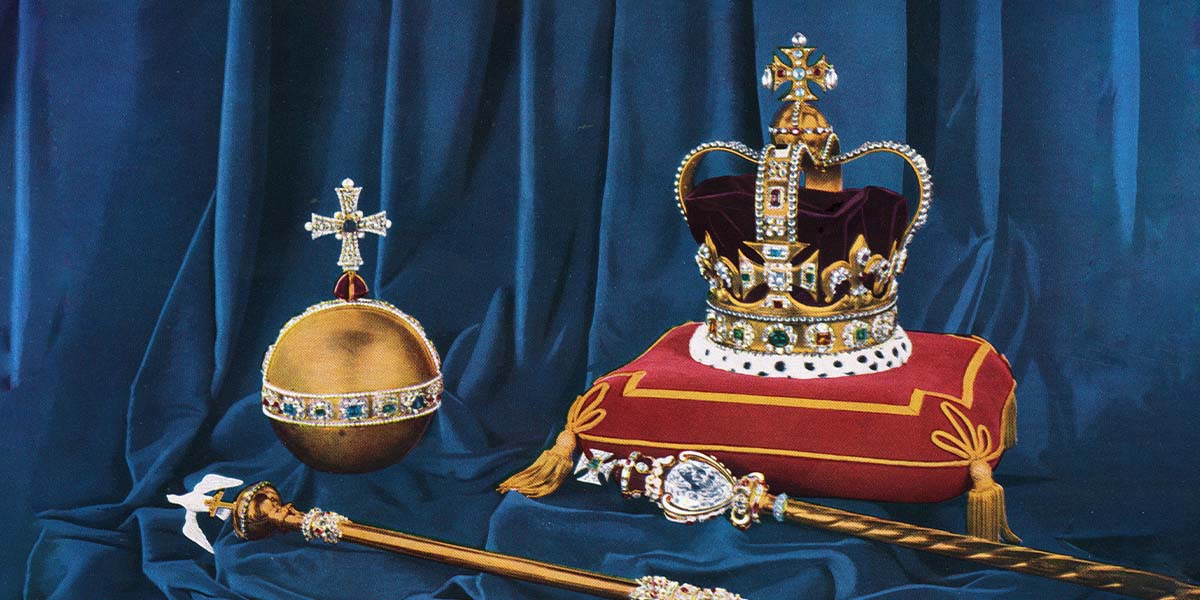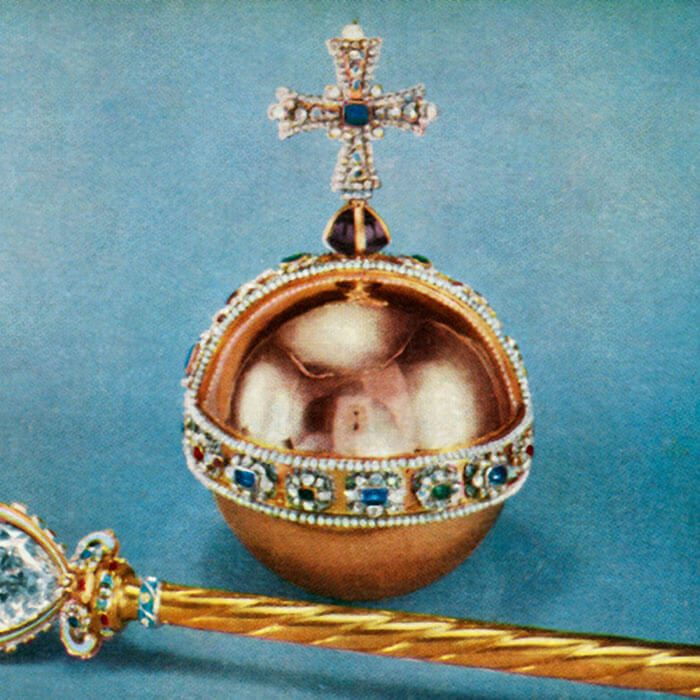The collection of symbolic objects used during the coronation ceremony of His Majesty King Charles III is known as the Coronation Regalia. As the most precious items in the Crown Jewels collection, they are kept at the Tower of London, one of The Royal Mint’s former homes.
Created for the coronation of Charles II in 1661, many of the most recognisable of these treasures were replacements for the medieval Crown Jewels destroyed by parliament after the execution of Charles I in 1649. Parliament ordered that the orb and sceptres be broken up. The jewels were removed and sold, whilst the gold and silver was melted down and used to make coins for the newly formed Commonwealth.
- Restoration
- The Sovereign’s Orb
- The Sovereign’s Sceptre with Cross
- The Sovereign’s Sceptre with Dove
- St Edward’s Crown
- The Coronation Spoon
- A Symbolic Design
The Restoration

Following the restoration of the monarchy in 1660, Charles II ordered new regalia to be prepared for his coronation a year later. The onerous task fell to Robert Vyner, the Royal Goldsmith, and his exceptional work forms part of the most complete collection of royal regalia in the world. The objects Vyner created for Charles II form a large proportion of the Crown Jewels collection and include the Sovereign’s Orb, the Sovereign’s Sceptre with Cross, the Sovereign’s Sceptre with Dove, and St Edward’s Crown.

The Sovereign’s Orb
Like the other objects in the regalia, the Sovereign’s Orb represents the monarch’s powers and responsibilities. A golden globe surmounted by a cross, it is handed to the monarch during the investiture and indicates that the monarch’s power derives from God.
The Sovereign’s Sceptre with Cross
Signifying good governance, the Sovereign’s Sceptre with Cross has been used at every coronation since that of Charles II. The sceptre contains the spectacular Cullinan I diamond, added in 1910 to be used at the coronation of George V.


The Sovereign’s Sceptre with Dove
Also referred to as ‘the Rod of Equity and Mercy’, this sceptre represents the monarch’s spiritual role, with the dove symbolising the Holy Ghost. After the monarch is invested with the sceptres and orb, they are crowned.
St Edward’s Crown
This spectacular crown is the most sacred in the Crown Jewels collection and only used at the moment the monarch is crowned. Made for the coronation of Charles II, it replaced a medieval crown said to have belonged to Edward the Confessor. Its solid gold frame weighs 2.23 kilogrammes and is adorned with gemstones.


The Coronation Spoon
One of the few items of regalia to survive from before the reign of Charles II is the Coronation Spoon. Dating from the twelfth century, the spoon is used for the most sacred part of the ceremony – the anointing of the monarch with holy oil. Its survival is down to Clement Kynnersley, one of the officials tasked with selling Charles I’s effects, who bought the spoon and returned it to Charles II at the time of the Restoration.
A Symbolic Design
The Sovereign’s Sceptre with Cross, the Sovereign’s Sceptre with Dove and St Edward’s Crown are beautifully brought together in Timothy Noad’s reverse design for the £5 coin that’s been struck as part of The Royal Mint’s Coronation of His Majesty King Charles III UK Coin Collection. The design skilfully frames St Edward’s Crown with the two sceptres in a design that elevates the Coronation Regalia, the sacred symbols of royalty.





